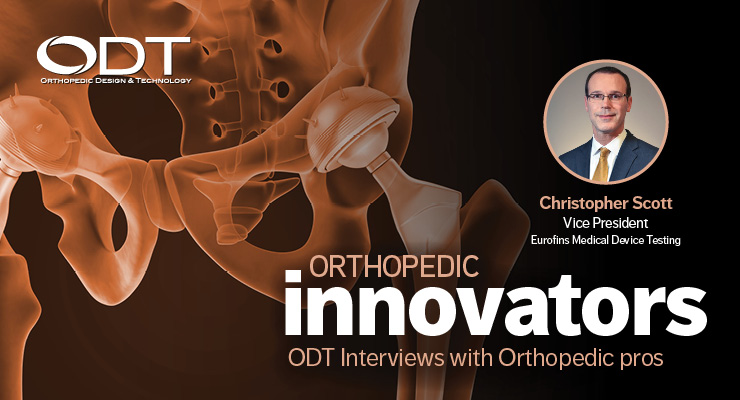Laboratory testing is a common requirement for all medical devices manufacturers, and orthopedics is no exception. As such, it is critical to find a partner who can offer the right services at all stages of development. Further, the testing provider must be able to address the specific needs of a manufacturer, within their region, and for the materials and technologies incorporated into the device.
As such, selecting such a partner can be a challenging task if the right considerations are not kept top of mind. Asking the right questions regarding capabilities and experience can determine the difference between a successful product launch or one struggling from costly delays.
With this in mind, Christopher Scott, Vice President of Eurofins Medical Device Testing, took time to discuss this issue. In the following interview, he addresses the pace of innovation today and its impact on laboratory testing, as well as the factors to consider when selecting a testing partner.
Sean Fenske: What is the most significant change that you have seen recently regarding the testing of orthopedic devices?
Christopher Scott: Although there are always updates and changes to testing requirements, standards, and expectations of the regulatory agencies, I think the most significant evolution is the direction in which medical device manufacturers are driving in the industry. With advances in manufacturing processes and the incorporation of computer technologies into their products and instrumentation, the pace of innovation is exponentially greater than it was just a few decades ago. As a result, the demands for testing have expanded greatly as well.
Fenske: But hasn’t the orthopedic sector always been innovative?
Scott: It certainly has been, but historically, many of the advancements in this industry have been incremental, building on existing technologies and using well-known materials. I think many observers would have attributed this to a risk-averse culture promoted by regulators and acquiesced to by manufacturers. There may be some truth in that, but I would suggest there was also a dependency on manufacturing technologies that limited breakthrough advancements as well as materials and computing power not quite ready for incorporation into mainstream device designs. As these new tools, processes, and technologies have been embraced by the orthopedic industry, we are seeing significant step changes in designs, and a culture of rapid innovation that is beginning to resemble the tech sector.
Fenske: How have regulators and standards organizations kept up with the rapid innovation?
Scott: It’s a great question, because keeping up with rapid innovation requires a nimble responsiveness that is difficult if historically bureaucratic workflows are maintained. Thus, these groups are being challenged to adapt.
Fenske: So how are orthopedic companies, and testing laboratories such as your own, dealing with this if regulators and standards organizations are struggling to keep up with technology?
Scott: Actually, the overarching requirements of the regulatory agencies still hold firm. Any new medical device must be safe and effective, and the basic approach of design verification and validation within a risk-based framework is as applicable for the latest breakthrough devices as it was for devices developed decades ago. What has changed, however, is there are not as many detailed consensus standards to guide manufacturers with generally accepted limits and specifications that can accommodate devices incorporating newer technologies. The agencies have become prolific in publishing Guidance Documents to shed light on current thinking and expectations, which is very helpful.
The change for manufacturers is incorporating novel technologies. For testing laboratories, the change is more emphasis is placed on design rationales for testing performed to support design verifications and validations, as compared to checking a box after a standard test method has been completed. It is becoming more common for customized test methods to be developed and used if standard methods do not meet the intention of confirming a device’s safety or effectiveness.

Eurofins’ 620,000 sq. ft. campus in Lancaster, Pa.
Fenske: Are there any other trends you see from regulators that are impacting the industry?
Scott: The FDA, as well as international agencies, have been placing a greater focus on data integrity for manufacturers and testing laboratories, particularly around electronic data. The impact for laboratories is an additional level of internal IT expertise is required to ensure the computerized management of testing data is fully compliant with Part 11 regulations and ALCOA+ data recording principles.
Fenske: What should orthopedic companies be thinking about when they approach a laboratory for testing?
Scott: Of course, you want to be working with an expert in the field. Manufacturers should be seeking someone who understands not just the testing aspect, but also the expectations of the regulatory agencies. Identify a testing partner that can provide guidance if there is a novel aspect to your device, or if a test’s results are not quite as was hoped for or expected.
Additionally, you should be thinking about the entire spectrum of testing required throughout the lifecycle of your product, not just the immediate testing need. There is substantial value in partnering with a laboratory that can support you throughout the development and commercialization of your device. Having a single point of contact that can provide a broad range of the testing needed is much easier than working with several different laboratories.
For larger manufacturers with a global footprint, you will want to consider a laboratory that operates on the same scale as yourself. A partner that can support your testing needs regardless of which continent your product is manufactured, regulated, or sold. Additional benefits to this consideration would include the ability to balance capacity across multiple lab locations, as well as conduct business in the language, time zone, and currency of your choice.
Fenske: Is there any other advice you would offer someone who is seeking a laboratory testing partner?
Scott: I’d suggest the same level of diligence be applied as is for sourcing a key raw materials supplier or subcontractor. A laboratory should be viewed as a critical partner in ensuring the success of your products and business. A partnership is, of course, a two-way relationship, and you need to feel as though your laboratory shares that sense of collaboration and mutual desire for the success of your products.
Fenske: Looking ahead, what do you predict for the future of testing for orthopedic devices?
Scott: I think if we look at the accelerating rate of technological advancement all around us in our day-to-day lives, then it helps to paint the picture of what we can expect to see in the orthopedic sector. It’s exciting to reflect back on the advances we’ve seen over the past decades, and even more exciting to think about what lies ahead. Wherever the winds of change take our clients, Eurofins Medical Device Testing stands ready to provide the spectrum of testing needed to bring their devices to market.
Click here to find out more about Eurofins Medical Device Testing >>>>>













